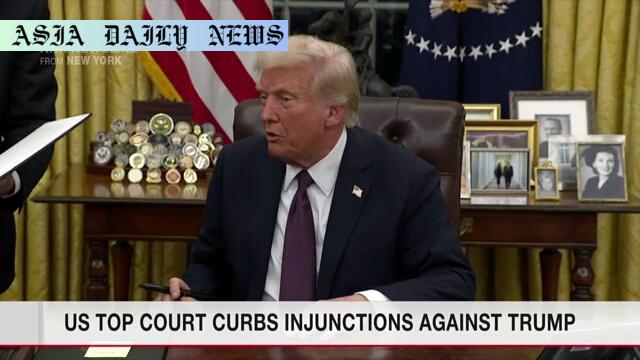Nationwide Injunctions – The US Supreme Court has limited federal judges’ authority from issuing rulings with nationwide effects.
Nationwide Injunctions curbed by the Supreme Court.
Federal judges’ authority to block policies nationwide is limited.
Trump’s policies faced consistent blockages via injunctions.

Supreme Court Limits Nationwide Injunctions
The United States Supreme Court issued a decisive ruling on Friday, limiting the ability of federal judges to grant nationwide injunctions. These injunctions, often used to temporarily block or halt government policies and executive orders, have long been a point of contention in American politics and governance. This particular decision emerges from a case involving the contentious topic of birthright citizenship, introduced in the framework of President Donald Trump’s immigration policy initiatives.
President Trump signed an order on his first day in office targeting birthright citizenship, which traditionally grants anyone born on U.S. soil citizenship, regardless of their parent’s immigration status. This encompassed babies born to mothers in the country illegally or temporarily, and children whose fathers lacked citizenship or permanent residency. However, successive federal judges utilized nationwide injunctions to block this and other initiatives, putting a legal halt nationwide.
The Implications of the Court’s Decision
This recent Supreme Court decision redefines judicial authority, putting robust checks on the ability of individual judges to issue rulings with nationwide effects. While the Court did not explicitly rule on whether Trump’s order was constitutional or not, it did introduce significant limitations against the use of such injunctions, underscoring that federal judges lack the authority to impose policies universally across the country as interim measures.
For many, the ramifications of this decision extend beyond immigration. It implies that localized rulings—previously enforceable across all 50 states—will now be confined to specific jurisdictions. Critics of the practice argue the ruling prevents federal courts from acting beyond their intended purview, yet proponents of the injunctions see them as critical for ensuring accountability of executive overreach.
The Debate on Nationwide Injunctions
The use of nationwide injunctions has been a divisive issue. Supporters of the practice argue that it provides victims of potentially unconstitutional government actions with immediate relief. It also ensures consistent application of the law until a higher court determines constitutional validity. On the other hand, critics believe nationwide injunctions impede the executive branch’s ability to implement policies efficiently and create a chaotic judicial environment distinguished by geographically inconsistent rulings.
In this context, the Supreme Court ruling presents a shift towards limiting the judicial activism that nationwide injunctions have symbolized for many critics. It is a reassessment of the judiciary’s role in policy and governance, signaling a potential recalibration of the balance of power among the branches of government.
The Broader Impact Across Policy Spectrums
The Court’s decision transcends the specific issue of birthright citizenship, suggesting a larger trajectory of judicial reform. Trump’s presidency marked an era where his administration encountered significant resistance in federal courts. From immigration bans to climate policies, injunctions frequently obstructed his agenda. This frustration boiled into calls among conservatives to curtail the practice. The Supreme Court ruling will undoubtedly influence other controversial areas, ranging from environmental laws to healthcare reforms, where injunctions have been used either to delay or uphold acts of government.
One area of concern, however, is how this decision might impact marginalized communities who often rely on legal mechanisms to rectify oppressive governance actions. By narrowing the reach of injunctions, laws or executive orders that adversely affect specific groups may not receive immediate nationwide pushback, leaving vulnerable populations without swift judicial remedy.
What’s Next?
While this ruling doesn’t settle the constitutionality of Trump’s birthright citizenship order, it changes the judicial landscape for future administrations. Both federal judges and policymakers must adapt to this recalibrated relationship of judicial authority. It leaves open the question of what alternative recourse will be available for those seeking broader or immediate relief against government actions.
The Supreme Court’s ruling underscores the delicate balance of power across the judicial, executive, and legislative branches of government. While some may celebrate this limitation as a win for streamlined governance, others will see the restraint of nationwide judicial authority as a setback to accountability and public interests. The face of American jurisprudence appears destined for an era of heightened debates and nuanced rulings.



Commentary
Restricting Judicial Overreach or Hindering Justice?
The recent Supreme Court ruling limiting the use of nationwide injunctions draws both praise and criticism. At its core, the decision signifies a major reform in judicial authority, better defining the bounds of federal courts. For proponents, it curbs what they perceive as judicial overreach—a practice where individual judges wield disproportionate influence by affecting policies across the entire nation. This reform promises to reinstate a more localized and balanced approach to justice.
However, not all feedback is celebratory. Critics argue that nationwide injunctions serve as an essential check and balance on executive overreach. In cases of urgent and widespread harm caused by policies, the power to block such measures on a national scale ensures that vulnerable populations and marginalized communities can secure immediate relief. By limiting this tool, justice might now become fragmented and slow-moving, leaving certain areas or groups more heavily impacted than others while awaiting higher court rulings.
Navigating a New Legal Landscape
From an analytical perspective, the reform also prompts questions about the practical application of justice. Federal courts historically ensured uniformity in rulings across the legal landscape, particularly on matters involving constitutional rights. This decision could lead to policy variances across states, increasing the likelihood of prolonged legal battles and judicial gridlocks, as conflicting rulings climb the ladder to the Supreme Court.
Nevertheless, the ruling aligns with a broader constitutional philosophy: emphasizing the separation of powers. For better or worse, it signifies a judiciary that is cautious in its intervention, prioritizing deliberation over immediate adjudication. For policymakers and legal professionals, this ushers in a pivotal shift that will likely reshape how governmental authority and checks are perceived in the years to come.